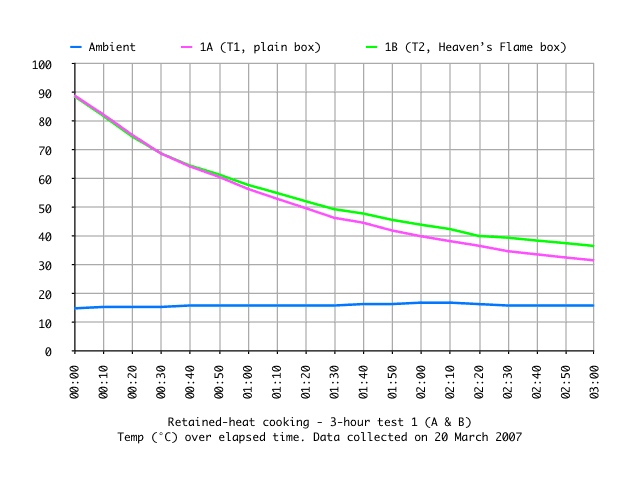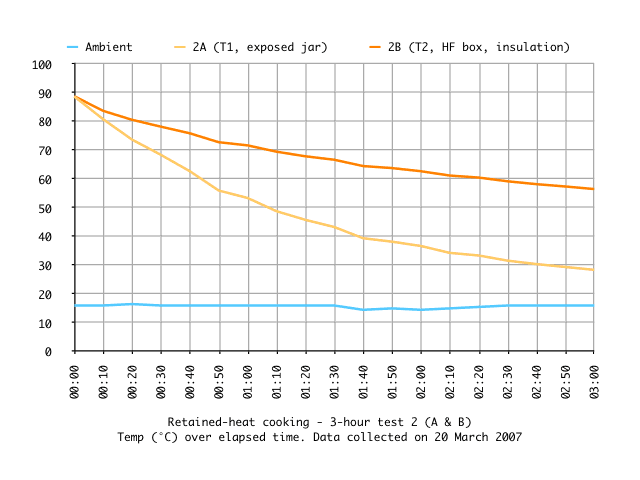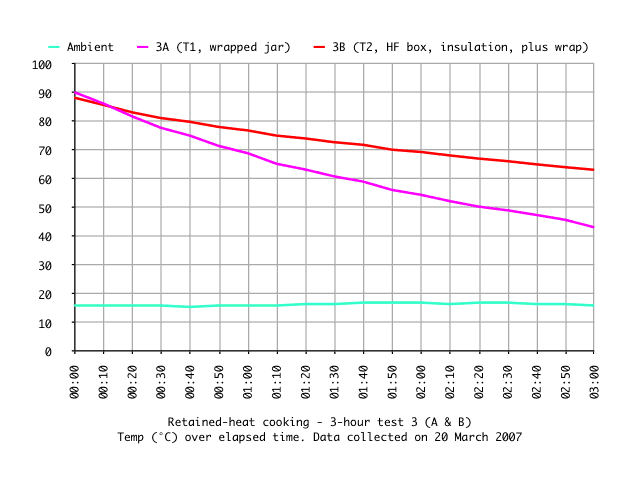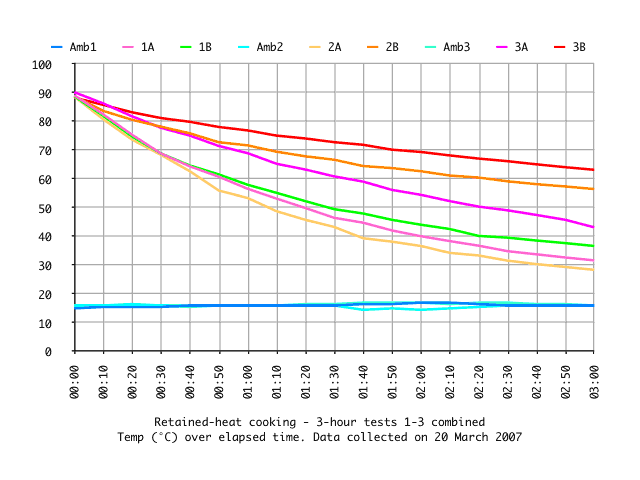| View previous topic :: View next topic |
| Author |
Message |
coconino
Joined: 21 Nov 2006
Posts: 77
Location: Sunny Brixton
|
 Posted: Wed Mar 21, 2007 11:42 pm Post subject: Retained-heat cooker experiments Posted: Wed Mar 21, 2007 11:42 pm Post subject: Retained-heat cooker experiments |
 |
|
The weather of the past few days not being conducive to solar cooking, but with time on my hands and an interest to learn, I've been testing the performance of various retained-heat cooking methods. Of particular interest was how well the Heaven's Flame oven box worked as a retained-heat cooker, since the thing is taking up space in my kitchen and it might as well earn its keep.
The tests were conducted in my (currently rather chilly) kitchen. In all cases the test material was a clear glass jar containing 500 ml of water poured from a boiling kettle. Testing was done with a digital thermometer attached to thermocouple probes permanently inserted through 2 mm holes in the lids of the jars. Ambient temperature was taken using a household thermometer. Each test lasted 3 hours. The Heaven's Flame oven box has 22 litres internal volume and walls made from 8 to 10 thicknesses of double-walled corrugated board. The oven opens upwards.
Test 1: enclosed boxes, no added insulation
The aim here was to test the Heaven's Flame oven against a standard corrugated cardboard box.
Test 1A: The jar was placed in a plain cardboard box of approximately 36 litres volume. The box was held closed by a small weight.
Test 1B: The jar was placed in the Heaven's Flame oven; the oven's opening was closed using the glass sheet and covered with the corrugated cardboard lid.

Test 2: exposed jar versus oven box with extra fibre insulation
Test 2A: The jar was merely closed and placed in the open beside the oven, without any additional insulation.
Test 2B: The jar was place in the oven box and surrounded sides and top with quilted insulation made from fibre-filled cushions. The insulation filled the volume of the oven. The oven was closed with the glass door and covered with the corrugated cardboard lid.

Test 3: bubble-wrapped jar versus oven box with fibre insulation plus bubble-wrapping
These tests used an additional insulation layer made from silver plastic bubble wrap of the type used in building insulation and exotic packaging.
Test 3A: The jar was wrapped tightly in a single layer of silver bubble-wrap and otherwise left in the open.
Test 3B: The jar was wrapped tightly in a single layer of silver bubble-wrap before being placed in the oven and surrounded with quilted fabric and the oven closed as before.

Combined results
When the graphs are overlaid it becomes clear that the order of performance is, from worst to best:
2A: no insulation at all
1A: enclosed in box
1B: enclosed in box with insulated walls
3A: wrapped in reflective bubble-wrap
2B: enclosed in insulated box with extra quilted insulation
3B: enclosed in insulated box with quilt and bubble-wrap

(Conclusions and notes below)
Last edited by coconino on Sat Sep 01, 2007 4:18 pm; edited 1 time in total |
|
| Back to top |
|
 |
coconino
Joined: 21 Nov 2006
Posts: 77
Location: Sunny Brixton
|
 Posted: Wed Mar 21, 2007 11:50 pm Post subject: Posted: Wed Mar 21, 2007 11:50 pm Post subject: |
 |
|
(For some reason the last bit of that post kept being chopped off, so here it is separately)
Conclusions
If cooking temperature is taken to be 82C and above then these tests suggest that cooking may only continue for 20 minutes or so even with substantial insulation. It is almost certainly the case, however, that a larger mass of hot food solids in a metal pan will retain heat much longer than hot water in a glass jar and therefore cook for longer. I hope to address this in a future test.
Notes
Following test 3 the test materials were left in situ and tested after 4.5 hours and 15 hours, at which point the bubble-wrapped jar in the oven was still 15C above the ambient temperature.
A further test (not illustrated here), suggests that pre-warming the insulation has a substantial positive effect.
Last edited by coconino on Sat Sep 01, 2007 4:18 pm; edited 1 time in total |
|
| Back to top |
|
 |
coconino
Joined: 21 Nov 2006
Posts: 77
Location: Sunny Brixton
|
 Posted: Thu Mar 22, 2007 8:19 am Post subject: Posted: Thu Mar 22, 2007 8:19 am Post subject: |
 |
|
It would be interesting to see how these results relate to solar-cooking situations where the temperature has peaked because sunshine has waned. It might be that the advantage of adding insulation within the box's void would be negated by losing heat due to having to open the box to insert the insulation.The results could also point to it being useful to fill as much of the void as possible when cooking -- but does this make it slower to heat up and cook?
Of course this is all guesswork, I've only just started using solar cookers and haven't actually cooked anything solid in one yet. I have used retained heat cooking before but not in any systematic way. It would be great to learn from others here who do have practical experience.
Last edited by coconino on Sat Sep 01, 2007 4:19 pm; edited 1 time in total |
|
| Back to top |
|
 |
Bill Bradley
Joined: 26 Nov 2006
Posts: 21
Location: Springfield MA USA
|
 Posted: Sat Mar 31, 2007 8:15 pm Post subject: Retained Heat Cooking reply Posted: Sat Mar 31, 2007 8:15 pm Post subject: Retained Heat Cooking reply |
 |
|
Good work. This is the kind of well controlled and documented test that we need more of in the solar cooking community. As you are showing, retained heat can be a useful supplement to solar cooking. However, it does require super insulation to cook for more than a few minutes. Vacuum bottles work well but any super insulated container will work. The more insulation the better.
_________________
Bill Bradley, EarthboundTech |
|
| Back to top |
|
 |
|






